“Science is the one human activity that is truly progressive. The body of positive knowledge is transmitted from generation to generation.” -Edwin Hubble
We really got into some wondrous stuff here at Starts With A Bang this past week, including:
- Can we see our galaxy's supermassive black hole? (for Ask Ethan),
- Averaging inanimate objects can produce human faces,
- A tribute to the greatest French nebula in space (for Mostly Mute Monday),
- Can we test dark energy using the Solar System?,
- The moon's two sides look so different thanks to 4.5 billion year old physics,
- and Happy birthday to the person who brought us the entire Universe: Edwin Hubble (a special for Edwin Hubble's 126th birthday).
The full stories are on Forbes, the ad-free versions come next week on Medium, and there was also one more special appearance... I was on my local TV station this week once again, talking about all the space and solar system news I could fit in to five minutes!
Image credit: Andrew Hamilton, of what the Earth orbiting a black hole would look like to an observer.
From JollyJoker on seeing a black hole: "What would we actually see though? Just a black circle with a distorted starfield behind it?"
If all you could see was the black hole -- if it were isolated -- that's all you'd get. Nothing, just blackness, with a distorted and lensed star field behind it. If there were other matter and you were looking in the visible, you might see something like Andrew Hamilton's simulation, above.
But we are looking in radio wavelengths, there's plenty of accelerated matter around it, including an accretion disk, plus there's whatever foreground emissions are present. Luckily, someone's already gone and created the visualization for what we could expect to see!
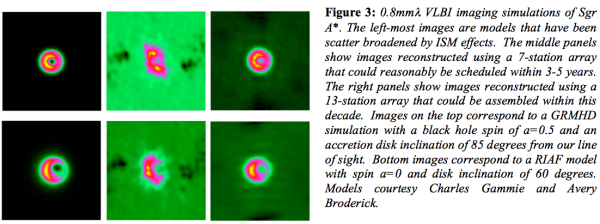 Image credit: S. Doeleman et al., via http://www.eventhorizontelescope.org/docs/Doeleman_event_horizon_CGT_CF….
Image credit: S. Doeleman et al., via http://www.eventhorizontelescope.org/docs/Doeleman_event_horizon_CGT_CF….
The interesting thing will come if we should see blackness for the event horizon... and don't. If, for some reason, the event horizon isn't just pure blackness, that will contradict the predictions of General Relativity as we understand them... and give us something very interesting to think about. We can hope!
Image credit: Dana Berry/NASA, of a neutron star (L) and a black hole (R), via http://www.nasa.gov/mission_pages/swift/bursts/short_burst_oct5.html.
From Waterbergs on black hole mergers: "...how do you get the black hole mergers that are meant to have created Sagitarius A* – the supermassive black hole at the centre of our galaxy? Surely from the perspective of an outside observer no two black holes can ever merge?"
Be very careful with this. While if you dropped a quantum of minuscule energy into a black hole, you'd see it only asymptotically approach the event horizon and get progressively redshifted, if you dropped a significant mass in there, you'd see the black hole's event horizon increase in size. In the case of black hole mergers, the size increase is significant and fast (on timescales of seconds-to-weeks in proper time, dependent on the black hole's mass), and so black hole merger happens just fine for an outside observer.
Images credit: Instagram, via the hashtag #FacesInThings, retrieved from Robby Kraft at http://robbykraft.com/sfpc/index.php?controller=post&action=view&id_pos….
From See Noevo on averaging human faces: "Do you believe Mt. Rushmore could happen by chance, if given enough time?"
From Michael Kelsey on averaging human intelligence: "Do you believe utter ignorance could happen by chance from generations of intelligent humans, if given enough time?"
Mount Rushmore, on Earth, by random chance? No. Not because it's impossible, but because the age of the Universe, the number of atoms on our planet and the potential lifetime of Earth is insufficient to have any sort of reasonable chance [something larger than one in 10^(10^100) odds] at producing something like Mt. Rushmore.
Ignorance? I often feel like ignorance is another word for, "I didn't do the math myself."
 Image credit: transcription of the Pilot Episode of Axe Cop, from http://tvtropes.org/pmwiki/pmwiki.php/Funny/AxeCop.
Image credit: transcription of the Pilot Episode of Axe Cop, from http://tvtropes.org/pmwiki/pmwiki.php/Funny/AxeCop.
Take a lesson from Axe Cop; if you do the math, you'll get the right answer, or at least the right odds of getting the right answer. But you have to do it right. And if you don't or if you won't, get your information from an expert who does.
From the Peak Oil Poet on dark energy tests in the Solar System: "i just can’t help often thinking that much of what we do right now is akin to Ptolemaic cycles within cycles – it’s just that we can’t see things any more clearly yet."
This is always a legitimate fear that we have, and perhaps one we ought to have. Are things in the Universe really this complicated? Do we need to know the positions, momenta, spins, masses, moments of inertia and all the other physical properties of everything in the Universe -- and an arbitrary amount of calculational power -- just to compute the orbit of one planet around the Sun to arbitrary accuracy?
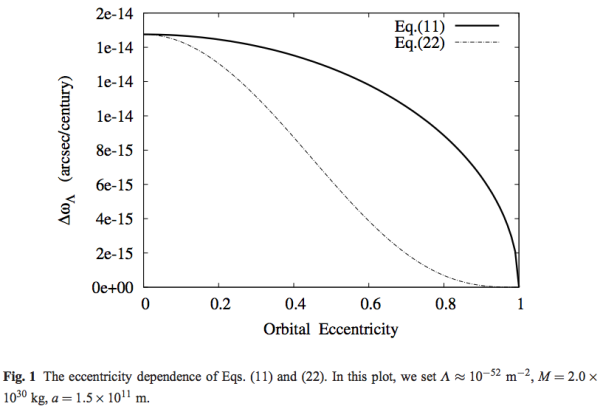 Image credit: Image credit: H. Arakida, via http://arxiv.org/pdf/1212.6289v1.pdf.
Image credit: Image credit: H. Arakida, via http://arxiv.org/pdf/1212.6289v1.pdf.
The thing is, if you want to get the answer to anything to something like, say, 20 significant figures, you need to add in anything that has potential effects at that level or greater, and you need to do it to that incredible precision. Dark energy may yet baffle us, and we may never uncover its origins or its true nature, but this is what trying looks like.
Your possibility is one we keep in mind, and that's why we play with the mental and theoretical gymnastics that we do. Someday, we may yet take that leap from Ptolemy to Copernicus, Galileo, Kepler and Newton that brought about modern physics. But then again, that leap may lead us right off a cliff. Right now, this cosmology -- the inflationary Big Bang with dark matter and dark energy -- works better than anything and everything else.
From See Noevo (a second comment this week called out?) on the formation of the Moon: "This article just assumes, as you do, that accretion happened, but addresses other problems with your theory."
I would read that article again, because that article offers a simple conclusion that I don't think you understood: the giant impactor formed at approximately the same distance from the Sun as the Earth did, and hence was made from the same materials with the same isotopic ratios.
Don't confuse "we don't know all the details about all the caveats of this scenario" with "this scenario is fatally flawed." The first iteration of inflation was wrong; but it got enough things right that we just needed to figure out how the rest of it worked. Hell, the first iteration of heliocentrism was wrong; Copernicus' model was worse than Ptolemy's! But the giant impact hypothesis -- swiftly becoming better known as the big splash -- is likely here to stay.
From Art on spray-painting the Moon: "Many years ago there was a plan floated to lighten the near-side of the moon to increase the amount of visible light returned to earth. The thought was that any time the moon was at half or greater people could save energy by turning off the lights. Free lighting; what could go wrong?"
What most people don't realize is that the reflectivity of the Moon is incredibly low: the Moon's albedo (or reflectivity) is about 11%, while a moon like Enceladus has a reflectivity of around 99%!
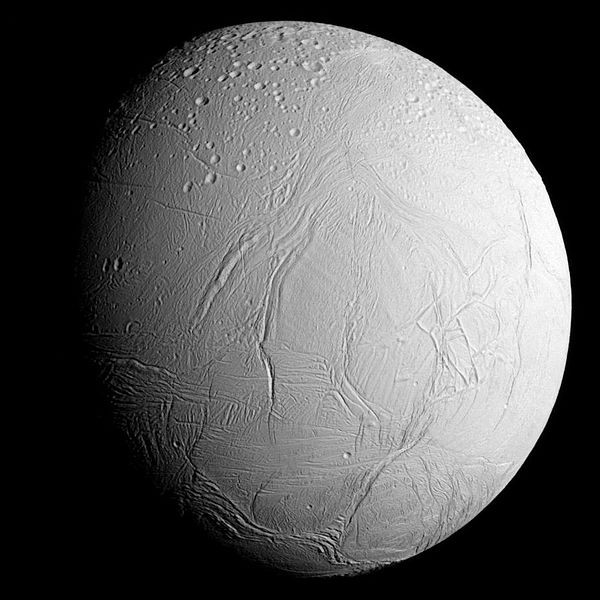 Image credit: National Aeronautics and Space Administration (NASA) / Jet Propulsion Laboratory (JPL).
Image credit: National Aeronautics and Space Administration (NASA) / Jet Propulsion Laboratory (JPL).
But what good would it do to increase the brightness of the Moon by a factor of 9? Well, I guess it would make things slightly brighter here on Earth. But is there any evidence that people use less electricity for lighting when the Moon is full? I often lament the Moon's light pollution when it's out; for me, it's the greatest natural source of light pollution. From an astronomical perspective, lightening the Moon would be a disaster. Remember what Nancy Reagan said: Just say no!
From Denier on the same topic: "I’m glad it is so far away and so big. You just know that if it were a reasonable job, they wouldn’t spray paint the near side white. They’d paint corporate logos, because the whole world needs to know you could save 15% on your car insurance in 15 minutes by calling Geico. If they’d had the technology in the 70’s, we’d probably still be looking at an ad for Marlboro."
Part of me worries that if something like Google Glass actually had taken off, and everyone were wearing those hideous glasses, we'd all be looking at something like this every time you looked at a certain object.
I have no idea if this is our dystopian future, if this is something we're actually going to see when the next series of Black Mirror comes out, or if this is literally in development right now. But no matter what, I definitely am glad that the natural beauty and wonder of some things still remains untouched in this world.
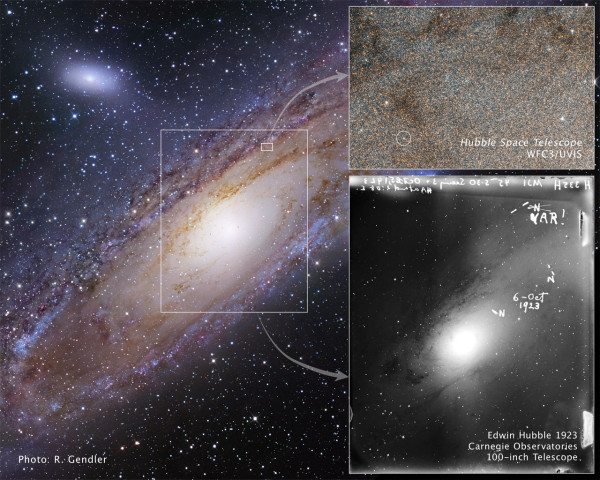 Image credit: E. Hubble, NASA, ESA, R. Gendler, Z. Levay and the Hubble Heritage Team, via http://apod.nasa.gov/apod/ap110701.html.
Image credit: E. Hubble, NASA, ESA, R. Gendler, Z. Levay and the Hubble Heritage Team, via http://apod.nasa.gov/apod/ap110701.html.
From Denier on Hubble (and someone else): "I know it was his birthday and all, but when mentioning the Hubble Constant it is worth at least giving a nod to Georges Lemaître."
So you don't have access to it yet, but I actually give the full story of what happened back in 1927 (Hubble's original "VAR!" discovery was 1923; Hubble's publication of his law and constant was 1929) in Chapter 3 of my upcoming book. Here's a snippet:
There is an interesting historical side-note concerning this discovery. Much later, it came to light that Georges Lemaître, using some of Hubble and Humason’s data, independently reached this same conclusion two years prior to Hubble’s paper, back in 1927. But Lemaître’s discovery of the redshift-distance relation, complete with a calculation of what is now known as “the Hubble constant,” was not published in English even upon the paper’s translation in 1931. Why not? Lemaître, living and writing in Belgium, and hence, in French, omitted that critical portion of the paper when he submitted it to the Royal Society in England, writing instead in a letter to the editor, “I did not find advisable to reprint the provisional discussion of radial velocities which is clearly of no actual interest, and also the geometrical note, which could be replaced by a small bibliography of ancient and new papers on the subject.”
You guys -- and by you guys, I mean the crew who follows me here on Scienceblogs, whose been with me longer than anyone else -- deserve to be among the first to know how to order my book and how to get it at an incredible discount.
You can now pre-order the book from World Scientific here: http://www.worldscientific.com/worldscibooks/10.1142/9547#t=aboutBook, and score yourself a cool 30% discount if you order this year by entering the promo code: WS15XMAS30.
If you head on over to that site, you'll also notice something else awesome: the first chapter is available for downloading for free! So go check it out and enjoy, and thanks for a great week of awesomeness. As always, there's plenty more to come!

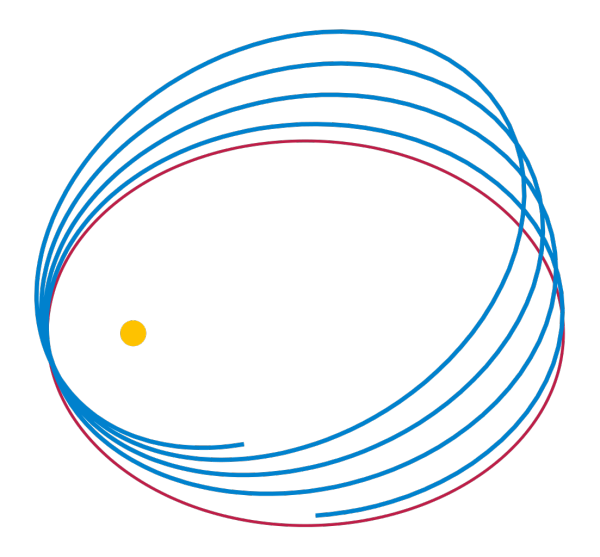
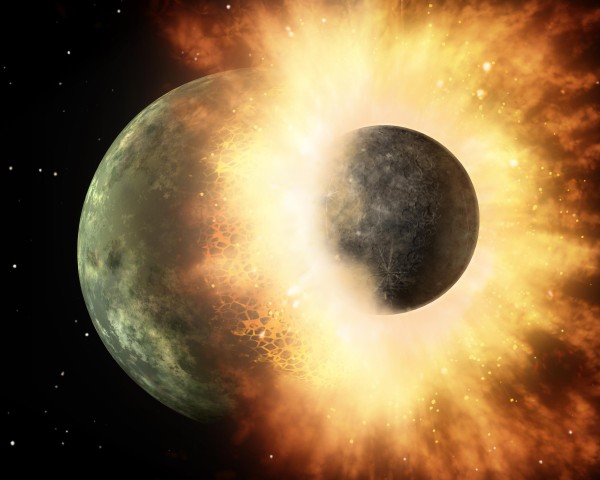
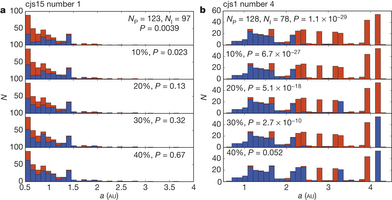

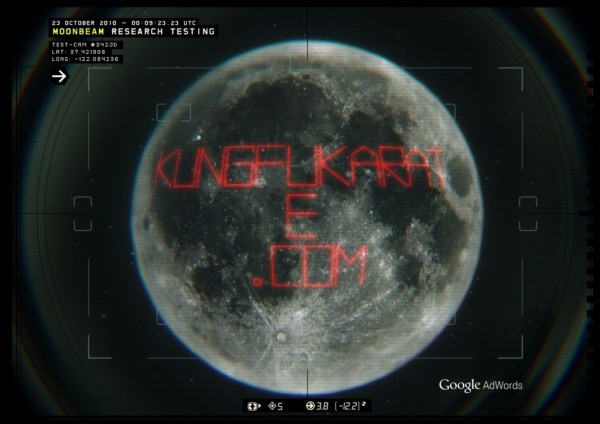

Further information on the Hubble Constant and Georges Lemaître:
When originally learning of this story, I seem to remember the reason the critical portion wasn't translated was because Albert Einstein criticized it. Prior to publication, he shared his finding with Einstein who replied with something to the affect of 'I can't find any fault in your math but your physics are atrocious'. Lemaître held Einstein in high esteem, and that scorching rebuke caused Lemaître to doubt his own work. The section wasn't translated because Lemaître was trying to save himself from further ridicule.
Hubble was the first widely published Hubble Constant paper, but a big reason for that was Albert Einstein's unwillingness to accept the validity of the idea.
Found a reference to the incident in the quote immediately below the chapter 4 title in this book:
THE VERY FIRST LIGHT: The True Inside Story of the Scientific Journey Back to the Dawn of the Universe